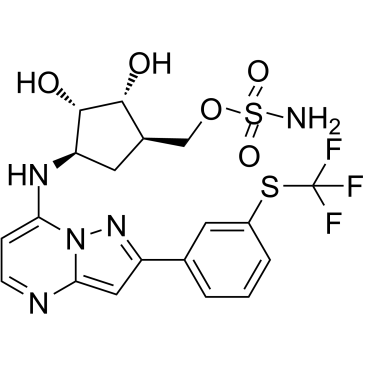| Cas No.: | 1450833-55-2 |
| Chemical Name: | Methyl ((1S,2R,3S,4R)-2,3-dihydroxy-4-((2-(3-((trifluoromethyl)thio)phenyl)pyrazolo[1,5-a]pyrimidin-7-yl)amino)cyclopentyl)sulfamate |
| Synonyms: | MLN7243;MLN-7243;AOB87172;AOB-87172;TAK 243;TAK243 |
| SMILES: | COS(=O)(=O)N[C@H]1C[C@H]([C@@H]([C@@H]1O)O)NC2=CC=NC3=CC(=NN23)C4=CC(=CC=C4)SC(F)(F)F |
| Formula: | C19H20F3N5O5S2 |
| M.Wt: | 519.514 |
| Sotrage: | 2 years -20°C Powder, 2 weeks 4°C in DMSO, 6 months -80°C in DMSO |
| Publication: | [1]. Hyer ML, et al. A small-molecule inhibitor of the ubiquitin activating enzyme for cancer treatment. Nat Med. 2018 Feb;24(2):186-193. [2]. Best SR, et al. TAK-243, a small molecule inhibitor of ubiquitin-activating enzyme (UAE), induces ER stress and |
| Description: | TAK-243 is a potent and selective ubiquitin-like modifier activating enzyme 1 (UBA1) inhibitor. |
| In Vivo: | TAK-243 significantly delays tumor growth in mice (T/C=0.02) with no toxicity as evidenced by no changes in mouse body weight, serum chemistry, or organ histology. TAK-243 reduces primary AML tumor burden in both tested samples without toxicity[2]. |
| In Vitro: | TAK-243 (MLN7243) selectively kills a subset of cutaneous squamous cell carcinoma (cSCC) lines. squamous cell carcinoma transplant (SCCT) and SCCRDEBMet cells are the most susceptible to continuous treatment with TAK-243. SCCIC1Met cells are also selectively killed by an extended exposure to TAK-243. Death in SCCRDEBMet cells displays the greatest sensitivity to a pulse of TAK-243. MLN7243 can reduce the cellular level of ubiquitin conjugates. TAK-243 decreases UBA1 and UBA6 thioesters and thioesters of the UBA6 specific E2 UBE2Z/USE1[1]. TAK-243 displays preferential activity towards acute myeloid leukemia (AML) cells over normal hematopoietic cells. TAK-243 reduces growth and viability of human AML cell lines (OCI-AML2, TEX, U937 and NB4) in a concentration- and time-dependent manner with IC50 's ranging from 15-40 nM after treatment for 48 hours[2]. |






















